What Led to the Battle of Bunker Hill?
The Battle of Bunker Hill was one of the early battles of the Revolutionary War and the most significant boxing of the Siege of Boston.
The Siege of Boston began after the Shot Heard Round the World took place in April of 1775 and the British retreated back to Boston where they were trapped within the city by the rebels.
The post-obit are some facts about the Battle of Bunker Hill:
What Was the Battle of Bunker Hill?
The Battle of Bunker Hill was a military conflict betwixt the American colonists and the British government during the Revolutionary War.
What Year Was the Battle of Bunker Loma?
The Boxing of Bunker Loma took place on June 17 in 1775.
Where Was the Boxing of Bunker Hill Fought?
The battle was fought on Brood's Loma in Charlestown, Massachusetts.
What Caused the Boxing of Bunker Hill?
The battle started after colonists heard of the British army's plans to take control of the hills of Charlestown and Dorchester and assault rebel posts in Roxbury and Cambridge in an attempt to end the siege, co-ordinate to the book Decisive Day: The Boxing for Bunker Loma:
"[General] Howe outlined the programme in a letter written on June 12 to his brother, the admiral. Beginning, a disengagement would move out against Dorchester neck, throw up two redoubts there, and then assail the insubordinate mail service in Roxbury. Once Boston was rubber from attack in that direction, Howe would take a large force to Charlestown heights and either attack the Americans in Cambridge or outflank that post, which would accomplish the same purpose. 'I suppose the rebels will move from Cambridge,' Howe added confidently, 'and that we shall take and keep possession of it.' The set on was set for June 18."
The British troops had been blockaded inside Boston by the American troops since the Siege of Boston began on April 19, 1775. The British army felt that if it could accept command of the hills surrounding Boston, they could intermission the occludent and accept complete command of Boston.
The colonists found out about the plan accidentally when an unidentified New Hampshire resident happened to learn of it in a conversation with a British officer and later reported information technology when he returned home to New Hampshire.
The issue was raised on June xiii at the Committee of Safety meeting in Exeter, New Hampshire, and word was quickly sent to the American troops in Boston.
To prevent the British troops from carrying out the plan, Colonel William Prescott and his men marched to nearby Brood's Hill, although they were originally ordered to go to Bunker Hill, on the night of June 16 and hastily congenital a big earthen fortification.
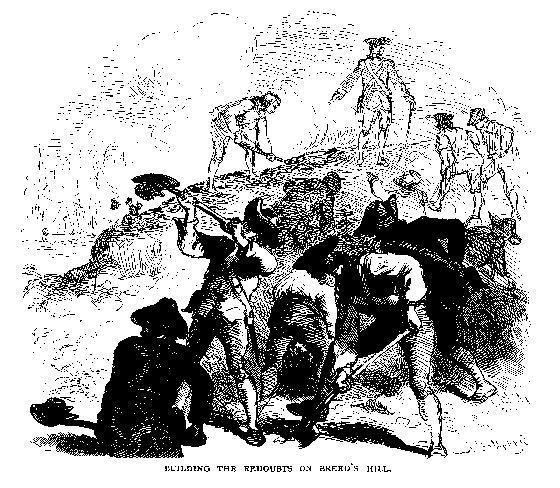
It is not known exactly why the troops concluded upwardly on Breed'due south hill instead of Bunker hill except that Prescott, Colonel Gridley and the other field officers decided it was a better location for their fortification, according to the book Boxing of Bunker Hill:
"The order was explicit equally to Bunker Hill; and yet a position in the pastures nearer Boston, at present known as Breed's hill, seemed better adjusted to the objects of the expedition, and better suited the daring spirit of the officers."
Despite the fact that the battle took identify on Breed's Colina, it even so came to exist known as the Battle of Bunker Colina.
Colonel Prescott troops consisted of somewhere betwixt 1,200-1,500 men, including General Joseph Warren, General Israel Putnam and General Henry Burbeck, who had helped brand armament for the battle alongside his father Lieutenant-Colonel William Burbeck.
When the British military saw the fortification on the colina in the early forenoon light, one of their ships anchored in Boston harbor, the "Lively," opened fire on it but did non cause much damage.
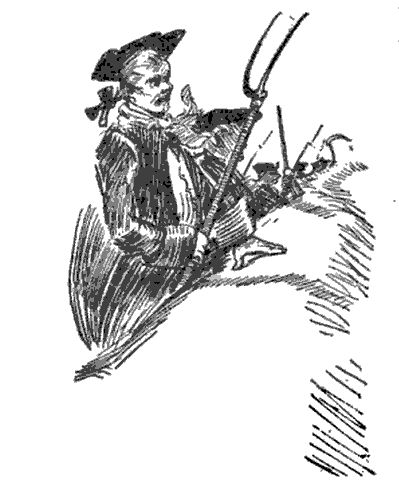
The ship was ordered to cease fire but Prescott'southward troops apace came nether fire again from a battery of guns and howitzers on Copp's hill, to little avail.
At near 3 p.m., over 2,000 British infantry soldiers arrived in Charlestown village and found themselves under sniper fire from the hamlet. In an endeavor to clear out the snipers, British troops fix fire to the town and burned information technology to the footing.
British General William Howe ordered the troops to meet at the base of the Breed'due south loma, clad in their bright red coats and conveying heavy equipment and bayonets, and accuse towards the colonists through the open fields on the hillside.
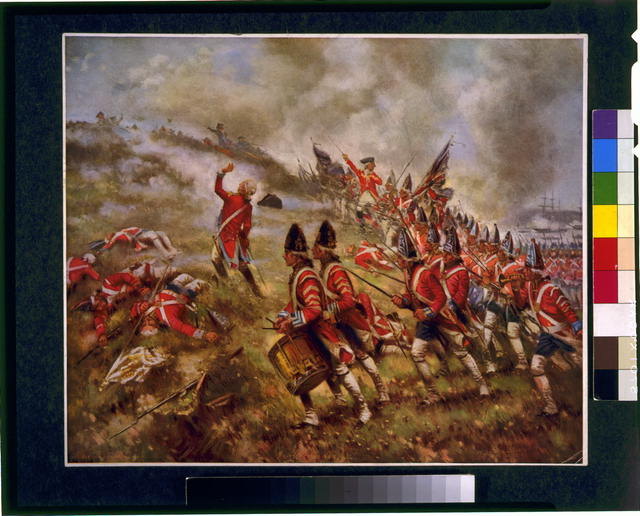
As the colonists watched their deadening advance, Colonel Prescott, realizing his men were low on armament, allegedly gave his famous order: "Don't shoot until y'all see the whites of their eyes."
When the soldiers were within 150 feet of the redoubt, the colonists opened burn. The British took heavy losses from this first round of fire and retreated back down the hill.
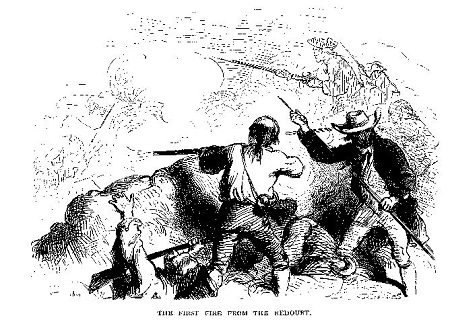
After regrouping, the British made a second charge upwardly the hill but were once more thwarted past heavy fire and retreat.
After waiting an hr, the British received 400 more soldiers from Boston and fabricated a third, and final, attempt at taking the hill, merely as the colonists ran out of armament.

The boxing was then reduced to close gainsay, during which many soldiers fought with nothing more than rocks and the butts of their guns, and the British finally took command of the hill.
Defeated and defenseless, the colonists retreated back up the Charlestown peninsula to Cambridge.
Battle of Bunker Hill Casualties:
The colonists suffered most of their casualties, including the decease of patriot leader Joseph Warren, not during the battle merely during the retreat.
The exact whereabouts of Warren after the battle was unknown but when he failed to reappear after the retreat, the colonists assumed he was killed in activeness.
Warren had in fact died from a shot through the head and British soldiers buried him on the hill in a shallow grave with another colonist.
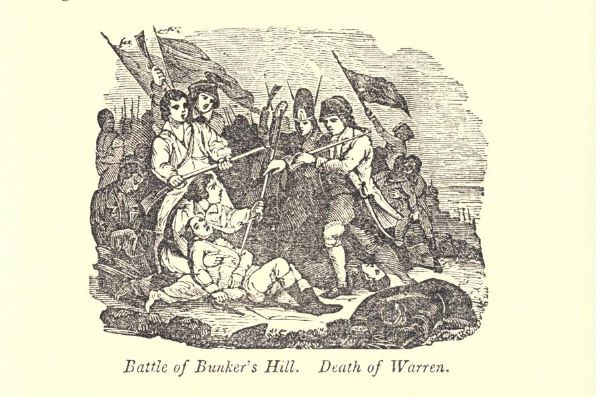
After the British left Boston in March of 1776, Warren's trunk was dug up and identified by Paul Revere who recognized Warren's two false teeth, which he had installed with a metal wire earlier in the yr.
The concluding colonist to dice during the battle was Major Andrew McClary, who was hitting by cannon fire from a frigate in the harbor while retreating through Charlestown neck, the narrow land span connecting the peninsula to the mainland.
McClary was thrown a few anxiety in the air by the cannon fire earlier landing dead, face up down on the ground. Fort McClary in Kittery, Maine was later named after him.
By the terminate of the three-hr battle, 268 British soldiers, including a large number of officers, and 115 American soldiers, lay dead and several hundred more were wounded. Near 30 American soldiers, well-nigh of whom were mortally wounded and couldn't physically escape, were captured.
However another casualty of the battle was General Thomas Cuff'southward military career. Gage was the commander of the British troops in Boston at the time and had ordered the assault on Brood's Hill.
When he later called for more British troops to exist sent to Boston later the battle, the British authorities turned against, according to the book Decisive Day: The Battle for Bunker Hill:
"The public and the government wanted a scapegoat and the first person they idea of was Gage himself. Here he was calling for more troops, implying that the government had been responsible for the failures in America; it was obvious that the man whom George III called 'the mild full general' had to go. Three days after the news of Bunker Loma reached London the decision was made to dismiss Gage and supervene upon him with William Howe."

Who Won the Battle of Bunker Hill?
Although the British won the Battle of Bunker Colina, it was but a technical victory. Their heavy losses during the boxing bolstered the colonist's confidence and actually encouraged them to continue fighting the state of war.
The British were however trapped within the city but were somewhen forced to leave Boston the following year in March of 1776 after the Battle of Dorchester Heights.
Boxing of Bunker Hill Historical Sites:
Bunker Loma Museum:
Address: 43 Monument Square, Charlestown, Mass.
Bunker Loma Monument:
Accost: Monument Square, Charlestown, Mass.
Sources:
Frothingham, Richard.Battle of Bunker Hill. Little, Brown and Visitor, 1890
Frothingham, Richard. History of the Siege of Boston. Fiddling, Brown and Company, 1849
Ketchum, Richard 1000. Decisive Day: The Battle of Bunker Colina. Doubleday, 1962
"Bunker Colina." The Freedom Trail Foundation, www.thefreedomtrail.org/visitor/bunker-hill.html
"The Boxing of Bunker Colina." National Parks Service, www.nps.gov/nr/twhp/wwwlps/lessons/42bunker/42facts2.htm
"Today in History June 17." Library of Congress, memory.loc.gov/ammem/today/jun17.html
Source: https://historyofmassachusetts.org/battle-of-bunker-hill/
Post a Comment for "What Led to the Battle of Bunker Hill?"